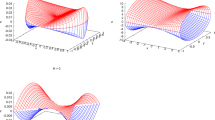Abstract
We consider the dynamics of a test particle co-orbital with a satellite of mass m s which revolves around a planet of mass M 0 ≫ m s with a mean motion n s and semi-major axis a s. We study the long term evolution of the particle motion under slow variations of (1) the mass of the primary, M 0, (2) the mass of the satellite, m s and (3) the specific angular momentum of the satellite J s. The particle is not restricted to small harmonic oscillations near L 4 or L 5, and may have any libration amplitude on tadpole or horseshoe orbits. In a first step, no torque is applied to the particle, so that its motion is described by a Hamiltonian with slowly varying parameters. We show that the torque applied to the satellite, as measured by ∈s = js/(n s J s) induces an distortion of the phase space which is entirely described by an asymmetry coefficient α = ∈s/μ, where μ = m s/M. The adiabatic invariance of action implies furthermore that the long term evolution of the particle co-orbital motion depends only on the variation of m s a s with time. Applying a constant torque to the particle, as measured by ∈s = js/(n s J p) is then merely equivalent to replacing α = ∈s/μ by α = (∈s − ∈p)/μ. However, if the torque acting on the particle exhibits a radial gradient, then the action is no more conserved and the evolution of the particle orbit is no more controlled by m s a s only. We show that even mild torque gradients can dominate the orbital evolution of the particle, and eventually decide whether the latter will be pulled towards the stable equilibrium points L 4 or L 5, or driven away from them. Finally, we show that when the co-orbital bodies are two satellites with comparable masses m 1 and m 2, we can reduce the problem to that of a test particle co-orbital with a satellite of mass m 1 + m 2. This new problem has then parameters varying at rates which are combinations, with appropriate coefficients, of the changes suffered by each satellite.
Similar content being viewed by others
References
Boccaletti, D. and Pucacco, G.: 1998, Theory of Orbits, Springer-Verlag, Vol. 2.
Fleming, H. J. and Hamilton, D. P.: 2000, 'On the origin of the Trojan asteroids: effects of Jupiter's mass accretion and radial migration', Icarus 148, 479-493.
Gomes, R. S.: 1998, 'Dynamical effects of planetary migration on primordial Trojan-type asteroids', Astron. J. 116, 2590-2597.
Henrard, J.: 1993, 'The adiabatic invariant in classical mechanics'. In: Jones, Kirchgraber and Walther (eds), Dynamics Reported, Springer-Verlag, pp. 117-235.
Jeans, J. H.: 1924, 'Cosmogonic problems associated with a secular decrease of mass', Mon. Not. R. Astron. Soc. 84, 2-11.
Lissauer, J. J., Goldreich, P. and Tremaine, S.: 1985, 'Evolution of the Janus-Epimetheus coorbital resonance due to torques from Saturn's rings', Icarus 64, 425-434.
Littlewood, J. E.: 1964, 'Adiabatic invariance II: elliptic motion about a slowly varying center of force', Ann. Phys. 26, 131-156.
Marzari, F. and Scholl, H.: 1998a, 'Capture of Trojans by a growing proto-Jupiter', Icarus 131, 41-51.
Marzari, F. and Scholl, H.: 1998b, 'The growth of Jupiter and Saturn and the capture of Trojans', Astron. Astrophys. 339, 278-285.
Marzari, F., Scholl, H., Murray, C. and Lagerkvist, C.: 2003, 'Origin and evolution of Trojan asteroids'. In: W. Bottke, A. Cellino, P. Paolichi and R. P. Binzel (eds), Asteroids III, University of Arizona Press, Tucson, USA, pp. 725-738.
Yoder, C. F., Colombo, G., Synnot, S. P. and Yoder, K. A.: 1983, 'Theory of motion of Saturn's coorbiting satellites', Icarus 53, 431-443.
Yoder, C. F., Synnot, S. P. and Salo, H.: 1989, 'Orbits and masses of Saturn's co-orbiting satellites, Janus and Epimetheus', Astron. J. 98, 1875-1889.
Author information
Authors and Affiliations
Rights and permissions
About this article
Cite this article
Sicardy, B., Dubois, V. Co-Orbital Motion with Slowly Varying Parameters. Celestial Mechanics and Dynamical Astronomy 86, 321–350 (2003). https://doi.org/10.1023/A:1024579912307
Issue Date:
DOI: https://doi.org/10.1023/A:1024579912307




